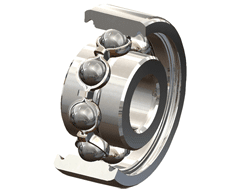Extremely low friction ball bearings for special gas and wind instruments
- Details
- Hits: 17123
 Devices for measuring the flow rate of liquids and gases or for measuring wind speeds, so-called anemometers, require extremely low-friction ball bearings. The GRW offers a special ball bearing with a special cage for such demanding applications. It fulfills the high requirements of the storage technology for anemometers with regard to the starting and dynamic friction torque as well as the temporal stability of the low friction torque. The new ball bearing cage is manufactured according to a patented process developed especially for this application.
Devices for measuring the flow rate of liquids and gases or for measuring wind speeds, so-called anemometers, require extremely low-friction ball bearings. The GRW offers a special ball bearing with a special cage for such demanding applications. It fulfills the high requirements of the storage technology for anemometers with regard to the starting and dynamic friction torque as well as the temporal stability of the low friction torque. The new ball bearing cage is manufactured according to a patented process developed especially for this application.
Anemometers place extreme demands on storage technology. In order to be able to measure even the smallest flow volumes or weak wind, the bearing has to be set in rotation with a low starting friction, especially with a minimum media flow. The constant low dynamic frictional torque is due to the fact that no micro-movements of the cage occur during the measuring or counting operation. These micro-movements would lead to random measured value peaks during the measurement, which falsify the measurement result and thus do not allow an exact determination of the flow rate. In addition, the ball bearing must show a reproducible discharge dynamics after switching off the media flow or wind down.
Patented process for friction-optimized cage
The special ball bearing from GRW Gebrueder Reinfurt fulfills the extreme requirements for anemometers both in terms of the reproducible starting torque as well as the minimum dynamic friction torque and its long-term stability. The high-precision ball bearing specialist has developed a new manufacturing process for friction-optimized cages, using a hybrid material as a combination of stainless steel and modified polymer. The substrate made of ferritic strip steel gives the cage the necessary strength and ensures the deep drawability for the manufacturing process. The plastic, a friction- and wear-modified fluoropolymer, is already applied as a film to the metal strip during semifinished product production. The hybrid strip produced in this way is finally further processed in a stamping and embossing process into two-part steel cloth cages.
Longer life even with insufficient lubrication
However unfavorable the circumstances in the application may be, the special ball bearing retains its outstanding sliding and frictional properties even in the case of insufficient lubrication. This is ensured by a transfer layer which is transferred from the cage surface via the balls to the raceways of the inner and outer ring and prevents solid contact after the loss of the hydrodynamic lubricating film. Experiments on a life tester have shown that lifetime lubrication can be guaranteed even in dry running when a maximum speed characteristic value nxdm 80.000 mm / min is not exceeded. Thus, even in the case of lack of maintenance of oil or grease lubrication ensures that with the use of special ball bearing still reliable operation is possible.
The new development of the ball bearing cage offers a drastic improvement compared to the previously used conventional ball bearings with two-piece steel lobe cage in oiled version as well as against cages whose cage surfaces were coated with galvanically deposited precious metals or applied by spraying or dipping process paint systems. These conventional designs have in contrast to the presented ball bearing only limited on the sliding and friction properties, which requires extreme use in gas and wind measuring instruments.
